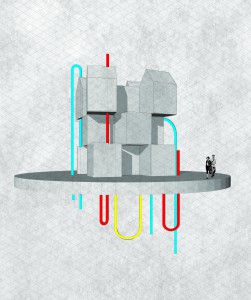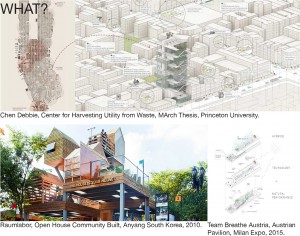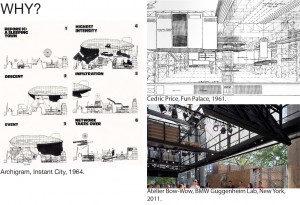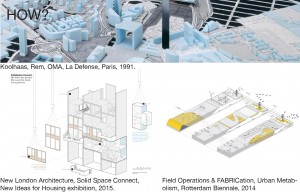|
Collective Sharing Open House

“Instead of being merely the producer of a unique three-dimensional product, architects should see themselves as programmers of a process of spatial change”.
-Ed van Hinte

Site, Scale, and Scope
The cities we live in today are full of complex flow of people and resources. It is important that cities optimize the use of available natural resources to save energy and cost. This thesis investigates the process of building an exhibition space that explores the system of urban ecology in district resource sharing. It looks at rethinking the role of exhibition space as a catalyst in neighborhood that encourage people to participate in sharing resources such as water and electricity.
This project will begin with a survey of urban voids (i.e. vacant lots) in cities in China to identify run-down neighborhood within a low density neighborhood block of the city. The scope of the project is to develop an open house for collective resource sharing in the neighborhood that is capable of transformation, mobility and adaptation. Based on the principle of co-housing, which is popular in Scandinavia, the open house is intend to encourage people to participate and share facilities such as laundries, study area, and cooking. The flexible public space will serve as a means for urban, social, and energy regeneration in the city. Over time, this prototypical space will transform to accommodate different functions and can be replicate to serve different neighborhoods in the city. Together, these resources sharing points can form a bigger network in the city to maximize the efficiency of resource sharing.

Historical and Current Discourse
As Keller Easterling describes “Upon completion, the stadiums are almost immediately at risk of obsolescence”, so what legacy can it left for a city? Since Vitruvius, the primitive hut has been origin of temporary architecture, but through Laugier’s image of the hut, we understand the relationship between man and nature. Temporary architecture such as world’s fair and exhibitions is in contrast with the permanent virtues of architecture in Vitruvius’ principles of utility, strength, and beauty because of the shortness of life cycle.
In recent years, green additions have taken on new forms in urban planning from remediating problem, introducing landscape to green technologies. As Dean points that,”while the expansion of the modern city once erased green, it is now urban development that paradoxically returns green (as either landscape or building ) to the city”. By harvesting and reusing natural resources, the flows of matter and energy in urban ecology can be realized in buildings, neighborhoods and beyond.
As said by Bernard Tschumi, “architects has the ability to design conditions and insert events into the space separating object from its significance”. The flexible resource sharing open space is not limited to a public space, but also serve to function as a catalyst that brings people together in sharing resources as Cedric Price has envision his Fun Palace to be engaging with people.

Method
The project will focus on investigating urban ecology based on resource sharing for future cities in developing a flexible public space that challenge the idea of conventional temporary architecture. In contemporary modes of living, buildings can evolve and change rather than demolish or left abandoned. This project will begin with a survey of urban voids in run-down cities in China to locate a site within a low density neighborhood block. Parallel to the survey, the project will study the various natural resources that can be harvest or reuse locally. It will explore how the flexible public space can transform and adapt to the neighborhood and connect to the city. The design will focus on designing a process to integrate these resource sharing points into a network of shared resources in the city.
Step 01 – mapping vacant lots and natural resources in Hong Kong (due 12/17)
Step 02 – temporal building massing study at site (due review 01)
Step 03 – network plan of sharing resource, temporal building massing and structural
design with different iterations (due review 02)
Step 04 – deployment network, final models and drawings (due review 03)
Bibliography:
- Koolhaas, Remment. Delirious New York: A Retroactive Manifesto for Manhattan. repr., 1978. Rotterdam, 010 Publishers, 1994, 85.
- Stan, Allen. Artificial Ecologies: the Work of MVRDV. El Croquis 86, 1997, 26-33.
- Tilder, Lisa., and Blostein, Beth. Design Ecologies. New York, Princetion Architectural Press, 2010. Print.
- Dean, Penelope. “Under Cover of Green”. Cuff, Dana., and Sherman, Roger. Fast-Forward Urbanism. New York, Princeton Architectural Press, 2011. Print.
- Easterling, Keller. Subtraction. Berlin, Sternberg Press, 2014. Print.
- Wilson, Rob. “Live Fast Die Young”. Uncube Megazine: 32, 45-51.
-
 International Building Exhibition IBA Hamburg. (http://www.iba-hamburg.de/en/story/format-iba.html) International Building Exhibition IBA Hamburg. (http://www.iba-hamburg.de/en/story/format-iba.html)
|